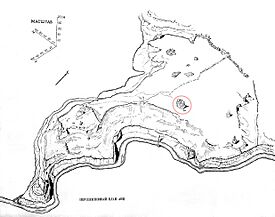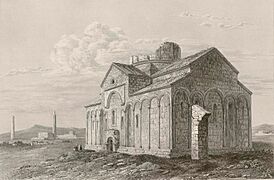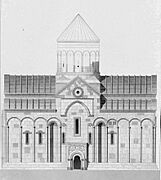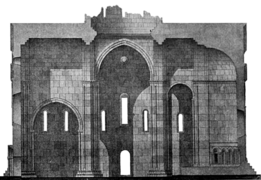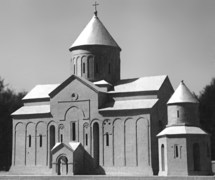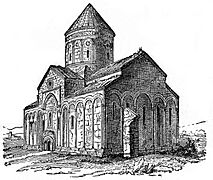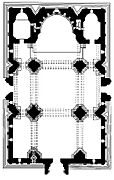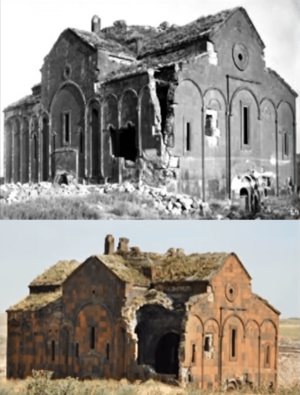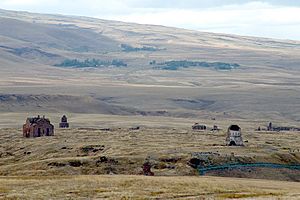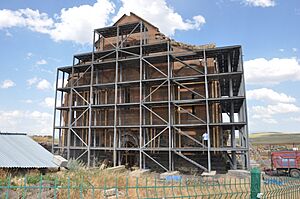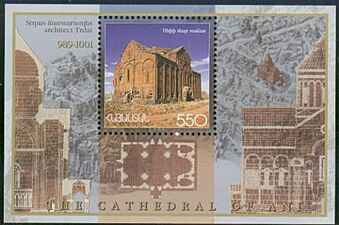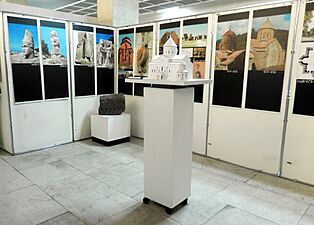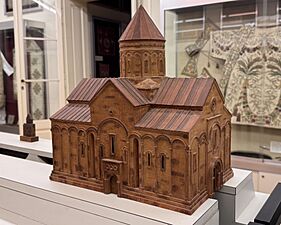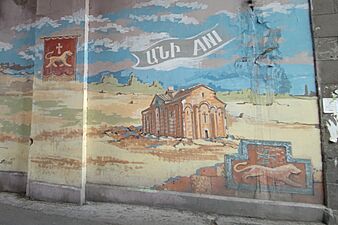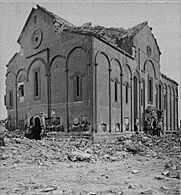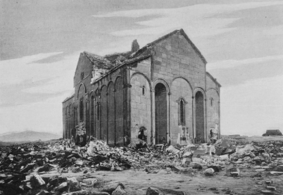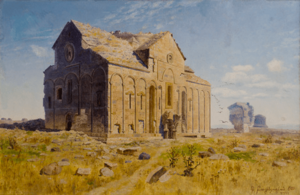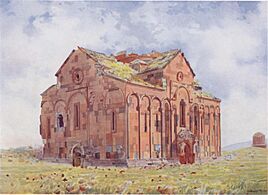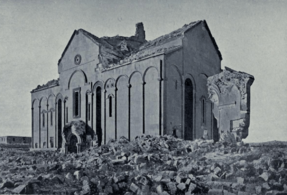Cathedral of Ani facts for kids
Quick facts for kids Cathedral of Ani |
|
|---|---|
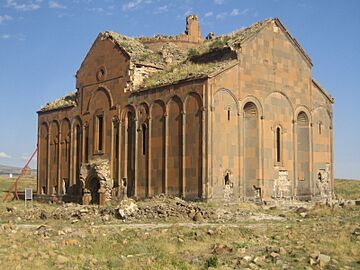
|
|
| Religion | |
| Affiliation | Armenian Apostolic Church |
| Location | |
| Location | Ani, Kars Province, Turkey |
| Architecture | |
| Architect(s) | Trdat |
| Architectural type | Domed basilica |
| Architectural style | Armenian |
| Founder | Smbat II of Armenia |
| Groundbreaking | 989 |
| Completed | 1001 or 1010 |
| Specifications | |
| Length | 34.3 m (113 ft) |
| Width | 21.9 m (72 ft) |
| Height (max) | originally: 38 m (125 ft) 24 m (79 ft) to the base of the dome |
| Official name: Archaeological Site of Ani | |
| Type | Cultural |
| Criteria | ii, iii, iv |
| Designated | 2016 (40th session) |
| Reference no. | 1518 |
| Region | Western Asia |
The Cathedral of Ani is the largest building still standing in Ani. Ani was once the capital city of the medieval Armenian kingdom. Today, it is located in eastern Turkey, very close to the border with modern Armenia.
This amazing building was finished in the early 11th century. Its architect was named Trdat. For almost 50 years, it was the main church for the Catholicos, who is the leader of the Armenian Apostolic Church.
In 1064, after the Seljuks took over Ani, the cathedral was used as a mosque. Later, it became an Armenian church again. A big earthquake in 1319 damaged it, causing its pointed dome to fall. Over time, people left Ani, and the church slowly fell apart. Another earthquake in 1988 caused more damage to its north-western side.
The Cathedral of Ani is seen as the biggest and most impressive building in the ancient city. It was a domed church with a rectangular shape. Even though its dome is now gone, its design with pointed arches and special columns might have influenced, or at least came before, Gothic architecture in Europe. In 2016, UNESCO declared the cathedral, along with the rest of Ani, a World Heritage Site.
Contents
Exploring the Cathedral's History
Building a Grand Church
After more than 200 years of Arab rule, Armenia became independent around 885 under the Bagratid dynasty. King Ashot III made Ani the capital in 961. Ani then grew into a busy city with many people.
The construction of the cathedral started in 989. King Smbat II asked the famous architect Trdat to build this important church. Work stopped when King Smbat died in 989. Trdat then went to Constantinople to help fix the dome of the Hagia Sophia church, which had fallen in an earthquake.
Trdat came back in 993. The building work continued under Queen Katranide, who was the wife of King Gagik I. The cathedral was finished in either 1001 or 1010. From 1001 until the mid-11th century, it was the main church for the head of the Armenian Apostolic Church. This made Ani both a religious and political center for Armenia.
A silver cross once stood on its dome, and a crystal chandelier from India hung inside. In the 1010s, a special tomb for the Hripsimean virgins was built next to the cathedral. In the 1040s and 1050s, messages were carved on the church walls about city projects. These included fixing the city walls, adding water pipes, and lowering taxes for the people of Ani.
Changes Over Time
Ani was taken over by the Byzantine Empire in 1045. Then, in 1064, the Seljuks, led by Sultan Alp Arslan, captured the city. Some sources say Alp Arslan and his soldiers prayed for the first time in Ani at the cathedral. Because of this, the cathedral was turned into a mosque, called Fethiye Mosque. Its silver cross was removed and taken to another mosque.
In 1124, a crescent symbol was placed on the dome. The Armenians of Ani asked King David IV of Georgia for help. He captured Ani, and the cathedral became a Christian church again. However, just two years later, in 1126, Ani was controlled by the Shaddadids. During the 12th century, several important scholars worked at the cathedral. In 1198, Armenian Zakarids princes took control of Ani, and the cathedral thrived. In 1213, a rich merchant named Tigran Honents helped fix the cathedral's steps.
The Cathedral's Decline
Ani began to decline in 1239 when Mongols attacked the city. A big earthquake in 1319 caused the cathedral's pointed roof to collapse. By the 18th century, Ani was completely empty. The part of the dome that supported it also fell during an earthquake in 1832 or 1840.
The north-western part of the cathedral was badly damaged by the 1988 Armenian earthquake. This earthquake had its center in modern Armenia. It created a large hole in the building. There was also a serious crack in the south-west corner, and parts of the roof started to fall by 1998.
There were also reports of damage from explosions in a quarry on the Armenian side of the border in the early 2000s. These explosions reportedly continued until 2004 or 2005.
Protecting the Cathedral
Ani has been on the World Monuments Watch list since 1996. This list is created by the World Monuments Fund (WMF). In May 2011, the WMF and the Turkish Ministry of Culture started a project to protect the cathedral and a nearby church. This project received funding from the U.S. State Department.
Before this project, a steel structure was put around the cathedral. This was to stop its cracked stone walls from falling apart. The WMF and its Turkish partner, Anadolu Kültür, planned to stabilize and protect the cathedral. Turkish officials hoped that bringing new life to these old buildings would help the local economy.
The archaeological site of Ani became a UNESCO World Heritage Site on July 15, 2016. This status helps protect the site and brings in more support for its preservation. In April 2018, restoration work on the cathedral was planned to begin. In 2019, the WMF and Anadolu Kültür started urgent temporary work to preserve the cathedral. In 2021, they began a second phase to restore the entire building for the long term.
Cathedral's Design and Features
What it Looks Like Inside and Out
The Cathedral of Ani is a domed church with a central plan, meaning it's designed around a central point. Its dome was supported by special arches and stood above four barrel vaults. Inside, tall, free-standing columns divide the space into three sections. The main section ends in a rounded area at the east, with two-story chapels on each side. Its interior feels grand because of its balanced design.
The outside of the church is decorated with blind arches and slender columns. Beautiful carvings around the doors and windows add to its beauty. The cathedral is mostly built from yellow stone, but also uses black and red polished stone. It has three entrances, with the main one on the western side. The windows are narrow and long, with decorative frames.
How Big is the Cathedral?
The cathedral is about 34.3 meters (112.5 feet) long and 21.9 meters (71.8 feet) wide. It was originally about 38 meters (124.6 feet) tall, making it the tallest building in Ani. Its pointed dome once stood high above the city. It is very large for Armenian architecture. Its size and rich decorations show the strength of the Armenian kingdom at that time.
Some visitors from Western countries thought it seemed small. However, others found it to be a very beautiful building with perfect proportions.
Why it's Special
Many experts believe the Cathedral of Ani is a masterpiece of Armenian architecture. It is the largest and most impressive building in Ani. It is known for its new design ideas. Experts have said it should be listed among the most important buildings of its time because of its pointed arches and special columns.
Some scholars have even suggested that the cathedral's use of pointed arches and clustered columns might have influenced the development of Gothic architecture in Europe. This idea was made popular by Josef Strzygowski, who studied Armenian architecture deeply. He believed Armenia played a central role in European architecture. While there's no direct proof of influence, the similarities are striking.
Other Churches Inspired by Ani
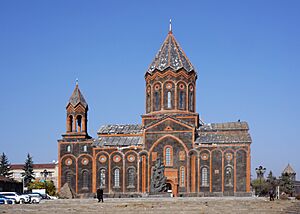
The main church of Marmashen Monastery (built between 988 and 1029) is thought to be a smaller version of the Ani Cathedral. It is believed to have been built by the same architect, Trdat. Both churches have similar decorations on their outer walls.
The Holy Saviour's Church in Gyumri, finished in 1873, was designed based on the Ani Cathedral. However, it is much larger and not an exact copy. The Armenian Cathedral of Lviv also has decorations on its walls that look very much like those on the Ani Cathedral.
Meaning for Armenians
The Cathedral of Ani is very important to Armenians. In 1989, events called "The Glory of Ani" were held in the United States to celebrate 1,000 years of the cathedral.
In Armenia, the cathedral has been shown on a stamp in 2002. In 2011, the Central Bank of Armenia released a special silver coin dedicated to Ani.
Since 2011, graduation ceremonies for history students from Yerevan State University (YSU) have been held at the cathedral. Other university departments have also held ceremonies there. People have even held wedding ceremonies at the cathedral. Researchers from Armenia have also visited the cathedral to study its history.
-
Street art in Yerevan depicting the cathedral
Images for kids
- Historic and artistic depictions
-
A 1900 painting of the cathedral by Gevorg Bashinjaghian, National Gallery of Armenia


